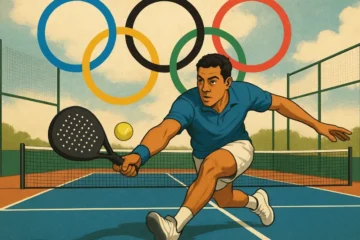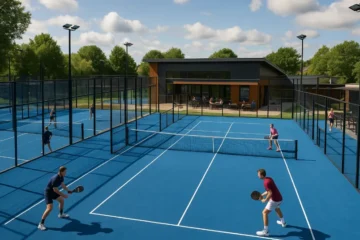Once a niche sport popular in Spain and Latin America, padel is now exploding across Asia. Combining elements of tennis and squash, this accessible, social sport has quickly found a fervent following from Tokyo to Singapore. Whether it’s in the bustling cities of Southeast Asia or the emerging markets of East Asia, padel is rapidly growing into the next big thing in sports.
In this article, we explore the drivers behind the boom, the key markets leading the charge, and what the future holds for Asia’s newest sporting obsession.
The Sound of a Revolution
Imagine walking through the heart of a bustling Asian city, perhaps Singapore, Tokyo, or Dubai. The air is filled with the unmistakable pop of a padel ball bouncing off the walls of a state-of-the-art court. Around the court, people of all ages, from corporate professionals to young families, are enjoying a fast-paced game that’s easy to learn but hard to master. This image is quickly becoming common in cities across Asia, as the sport of padel is transforming from a niche activity to a mainstream sensation.
What is Padel?
For those unfamiliar, padel is a racquet sport that combines elements of tennis and squash. Played in doubles on a smaller, enclosed court, it involves bouncing a ball off the walls, much like squash. The sport is similar to tennis but with simplified rules—there are no high serves, and the court is smaller, making it more accessible. It’s fast, fun, and easy to pick up, and with its emphasis on doubles, it’s an inherently social sport. It’s perfect for those looking to combine fitness with social interaction.
Why Padel? The Perfect Storm for Asian Markets
A. The “Easy to Learn, Hard to Master” Appeal
One of the biggest draws of padel in Asia is its relatively low barrier to entry. The game is simple enough for beginners to get started almost immediately. Unlike tennis, where it might take months to master serving or rallying, padel allows players to rally quickly, making it less frustrating and more rewarding right from the start. This “easy to learn, hard to master” dynamic has made padel particularly attractive to newcomers, including those who may have been intimidated by more traditional racquet sports.
B. The Social & Networking Engine
Padel is a doubles-focused game, which gives it a natural social component. For many players, it’s not just about the sport—it’s about the connections and relationships that form around it. In business-centric Asian cities, padel is becoming an essential networking tool, with professionals playing as a way to bond over something active outside of the office. In some cases, it’s even replacing golf as the go-to sport for business meetings and socializing.
Families and friends are also drawn to the sport because of its lighthearted, social atmosphere. It’s a game where communication and teamwork are key, making it an ideal option for bonding.
C. Urbanization and Space Efficiency
Padel’s popularity in Asia is also driven by the urbanization trend in the region. With densely populated cities and limited space for large-scale sports facilities, padel courts are a perfect solution. They require far less space than a traditional tennis court, and many can be built on rooftops, in warehouses, or at urban recreational centers. This makes them ideal for space-starved Asian cities, where real estate is expensive and every square foot counts.
D. The Post-Pandemic Fitness Boom
As the world emerged from the COVID-19 pandemic, there was a global surge in interest for outdoor, socially-distanced fitness activities. People were eager to find ways to stay active while avoiding crowded gyms. Padel, with its open-air, socially distanced nature, quickly filled this gap. In many cities, local governments and businesses have supported the construction of new padel courts as part of their efforts to promote public health and wellness.
Mapping the Boom: Asia’s Padel Hotspots
A. The Gulf Connection: UAE and Qatar as Gateways
The United Arab Emirates (UAE) and Qatar have been critical in introducing padel to Asia. Dubai and Doha serve as gateways, not just for their local populations but for a large expat community. These Gulf cities are known for their cosmopolitan lifestyle, luxury sports facilities, and desire to offer cutting-edge activities. The introduction of padel to these cities has made it more accessible to residents and expatriates who have encountered the sport during their time in Europe or Latin America. As a result, both cities have seen a sharp rise in padel courts, with more popping up every year.
B. Southeast Asia’s Frontrunners
Singapore: Singapore is emerging as one of the biggest padel hubs in Southeast Asia. The city-state has a large number of high-profile padel clubs like Padel Singapore and The Padel Co., which have gained significant attention. Central locations, easy access, and sponsorship from big brands are helping padel grow in the region. With its blend of business, tourism, and fitness culture, Singapore is a prime market for padel’s expansion.
Thailand: In Thailand, padel is gaining traction in cities like Bangkok and tourist hotspots like Phuket. The sport fits seamlessly into the Thai lifestyle, combining physical activity with social engagement. Expats, as well as local communities, are flocking to newly built courts, creating a buzz around the sport. Thailand’s growing interest in padel is likely to see it expand rapidly in the coming years.
Malaysia: In Malaysia, Kuala Lumpur is leading the way with several padel clubs catering to the city’s middle class, who are becoming more interested in sports and fitness. The country’s steady growth in padel has been largely driven by the growing appetite for international sports and social games.
C. East Asia’s Emerging Giants
Japan: Padel is in its early stages in Japan, but the sport is already making waves. Tokyo is home to a growing number of courts, and there’s a palpable buzz around the sport. Japan’s sports-loving population and high level of interest in new activities make it an ideal location for padel’s growth.
China: China represents the ultimate potential market for padel in Asia. While still in its early stages, there’s significant interest in the sport in major cities like Shanghai and Guangzhou. China’s vast population, growing middle class, and increasing interest in fitness and lifestyle sports make it a goldmine for padel’s future expansion.
South Korea: South Korea has been slower to adopt padel, but interest is steadily growing, particularly due to its strong tennis culture. As the sport gains visibility and more people experience it firsthand, padel could see a significant rise in popularity across the country.
D. The Indian Subcontinent
India: India’s burgeoning middle class and growing interest in sports has paved the way for padel’s introduction. Early movements in cities like Mumbai and Bangalore have been spearheaded by private clubs catering to affluent individuals who’ve encountered padel abroad. With the rise of professional and amateur leagues, India is poised to become a key player in Asia’s padel scene in the coming years.
Faces of the Game: The People Powering Padel’s Growth
The Entrepreneurs
Behind every successful padel club or facility, there’s an entrepreneur. Local business owners and investors are betting big on the sport, realizing the potential for growth. Many of these entrepreneurs have capitalized on the growing interest in fitness and social sports, seeing padel as a smart investment for the future.
The Coaches & Pros
To nurture local talent, international coaches and professionals from padel powerhouses like Spain and Argentina are coming to Asia. Their expertise is invaluable in helping local players develop their skills and grow the sport organically. These coaches also play a key role in training the next generation of padel stars in Asia.
The Community Builders
Social media groups, amateur leagues, and corporate tournaments are playing a vital role in fostering a vibrant padel community. These platforms help connect players, encourage friendly competition, and create a network of enthusiasts who are passionate about the sport’s future.
Challenges on the Court: Obstacles to Overcome
While padel’s rise in Asia is impressive, there are still significant hurdles to overcome.
Awareness & Education
For many in Asia, padel is still a foreign concept. The challenge of educating the public about the sport and its appeal remains one of the biggest obstacles. Many people are still asking, “What is padel?” and may be unfamiliar with the rules or the fun factor of the game.
Infrastructure & Cost
Building quality padel courts requires significant investment. The cost of constructing these courts, particularly in urban areas where space is limited, is a challenge. As a result, membership and play fees can be prohibitive for some, limiting the sport’s accessibility.
Governance & Structure
To ensure sustainable growth, Asia needs national federations and a standardized governance structure to avoid fragmentation. This includes clear rules, development pathways for players, and international tournaments that create a competitive landscape.
Cultural Competition
Padel also faces stiff competition from deeply entrenched sports like badminton, table tennis, and increasingly, pickleball. These sports have long histories and established fan bases in many Asian countries, making padel’s rise even more impressive.
The Future of Padel in Asia: A Look Ahead
Path to Professionalism
Looking ahead, the path to professionalism for padel in Asia seems bright. The rise of regional tournaments, Asian tours, and the potential for homegrown stars will create an exciting new dimension to the sport. As more players emerge, the region could become a competitive hub for international padel events.
Mainstream Integration
Padel is set to become an integral part of the mainstream sporting landscape in Asia. Predictions point to its inclusion in school programs, larger real-estate developments (as a key amenity), and broader media coverage.
Innovation
As technology continues to evolve, the sport of padel will also benefit. Innovations like improved booking systems, wearable tech for players, and virtual reality training could transform the way the sport is experienced and enjoyed.
Olympic Dreams?
There is even speculation that padel could one day be included in the Olympic Games. If this happens, it would significantly accelerate the growth of the sport across Asia, creating new opportunities for players and fans alike.
Conclusion: More Than Just a Game
Padel’s meteoric rise across Asia is a testament to the growing demand for accessible, social, and fitness-oriented sports. The combination of urban lifestyle trends, strategic investment, and a post-pandemic thirst for social sports is fueling its rapid expansion. As more people experience the sport and communities come together around it, padel is on track to become a permanent fixture in Asia’s sporting and social landscape.
The future of padel in Asia is bright, and it’s only a matter of time before the sound of that pop becomes as common as the crack of a badminton shuttle or a soccer ball in the region.
FAQs:
1. What is padel?
Padel is a racket sport that combines elements of tennis and squash. It’s played on a smaller, enclosed court with walls, and typically in doubles. The game is fast-paced and easy to learn, making it a popular choice for beginners and social players.
2. Why is padel so popular in Asia?
Padel’s popularity in Asia is driven by several factors: its low barrier to entry, social and networking benefits, the urbanization trend (space-efficient courts), and the post-pandemic boom in fitness and outdoor sports. These factors make it a perfect fit for rapidly growing cities in Asia.
3. Where are the best places to play padel in Asia?
Some of the top locations for padel in Asia include:
- Singapore: Padel Singapore and The Padel Co.
- Thailand: Bangkok and Phuket, popular among expats and tourists.
- UAE & Qatar: Dubai and Doha are key hubs, especially for business professionals.
- Japan: Tokyo has seen a growing interest in padel.
4. Is padel difficult to learn?
No, padel is relatively easy to pick up for beginners. Unlike tennis, which requires mastering complex skills like serving, padel allows players to start playing quickly. The smaller court and doubles format make it more approachable.
5. What are the benefits of playing padel?
Padel offers numerous benefits: it’s a full-body workout, improves coordination, promotes teamwork, and is a great social activity. It also provides a fun way to engage in outdoor fitness, particularly in urban settings where space is limited.
6. Is padel going to be included in the Olympics?
There is speculation that padel could be included in future Olympic Games. The growing international interest and the establishment of professional tournaments make it a potential contender for the Olympic roster.
7. How can I get started with padel in Asia?
To get started with padel, look for local clubs, courts, or recreational centers in your area. Many clubs offer beginner lessons, and it’s easy to join social or corporate leagues to meet other players.




